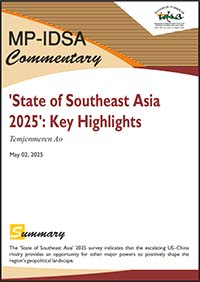‘State of Southeast Asia 2025’: Key Highlights
- May 02, 2025 |
- IDSA Comments
Table 1. If ASEAN were forced to align itself with one of the strategic rivals, which should it choose?
| Country | China | The United States | ||
| Year | 2024
|
2025 | 2024 | 2025 |
| ASEAN- 10
|
50.5% | 47.7% | 49.5% | 52.3% |
| Brunei
|
70.1% | 55.0% | 29.9% | 45.0% |
| Cambodia
|
45.0% | 43.0% | 55.0% | 57.0% |
| Indonesia
|
73.2% | 72.2% | 26.8% | 27.8% |
| Laos
|
70.6% | 51.0% | 29.4% | 49.0% |
| Malaysia
|
75.1% | 70.8% | 24.9% | 29.2% |
| Myanmar
|
42.3% | 42.3% | 57.7% | 57.7% |
| Philippines
|
16.7% | 13.6% | 83.3% | 86.4% |
| Singapore
|
38.5% | 47.1% | 61.5% | 52.9% |
| Thailand
|
52.2% | 55.6% | 47.8% | 44.4% |
| Vietnam
|
21.0% | 26.5% | 79.0% | 73.5% |
| Timor-Leste | N.A. | 40.9% | N.A. | 59.1% |
Source: The State of Southeast Asia Survey 2025.
Note: ASEAN-10 is the average of all the respondents from the ten ASEAN Member States.
The overall shift in favour of the US could be attributed to President Trump’s efforts to end the war between Russia and Ukraine and, the conflict in Gaza. If these are achieved, it could help restore some global order; a pre-requisite for Southeast Asian economic growth. There is also an expectation that under President Trump, there would be a strategic refocus on the Indo-Pacific, which will be welcomed in Southeast Asia. The survey reported that 44.9 per cent of Southeast Asians are confident that the US would be a strategic partner and provider of regional security, as against 34.9 per cent in 2024. According to the survey, 46 per cent Southeast-Asians expect bilateral relations with the US in the next four years to improve under President Trump.[ii] However, this sentiment is not uniform across all the ASEAN states on account of concerns over Trump’s unpredictability and his commitment to multilateralism.
One of the key factors that caused this shift in the region’s preference between the two major strategic rivals is the persisting mistrust vis-à-vis China. While as per the survey China continues to remain the most influential economic (56.4 per cent) and political-strategic power (37.9 per cent), concerns continue to grow over Beijing’s political and strategic influence in the region, with nearly seven in ten ASEAN respondents saying they remained wary. This is also on account of growing concerns relating to Beijing’s ongoing actions in the South China Sea. This year, the top geopolitical concern was aggressive behaviour in the South China Sea cited by 51.6 per cent of respondents. Aggression being witnessed in the disputed waters of the South China Sea overtook the ongoing Israel–Gaza conflict which was the region’s top concern last year.[iii]
The conflict between Israel and Hamas in the Gaza Strip which began on 7 October 2023, continued to escalate throughout 2024. Despite Southeast Asia being far from the conflict, there was an economic spillover effect on the region. Both Israel and Palestine are key trade partners for ASEAN nations with increasing global supply chain linkages. Amongst foreign workers in Israel, Thais constitute the largest group at 23 per cent followed by Filipino workers at 21 per cent. With economic interdependencies on account of expanding global supply chains, labour migration made the Israel–Palestine conflict relevant to Southeast Asia.[iv]
Apart from the economic impact, there is also the security dimension whereby there was increasing tendency amongst Islamist radical groups in Southeast Asia capitalising on the conflict to advance their ideological goals. On 2 February 2025, Indonesia witnessed large-scale demonstrations across cities in West Java, Central Java, South Kalimantan and Yogyakarta. The protests, organised under the Aliansi Muslim Bela Palestina, demanded an end to Israel’s attacks on Gaza and its occupation of Palestinian territories. The Hizb ut-Tahrir Indonesia (HTI), an Islamist group could be behind these protests, as the group has been active through its digital and social media campaigns.[v] Therefore, as Southeast Asian nations were deeply connected to the developments in Gaza, it was the region’s number one geopolitical concern in the 2024 survey.
In 2024, the South China Sea remained one of the most geopolitically sensitive regions in the world with increasing instances of the various parties asserting their territorial and maritime claims. The Philippines reported multiple encounters with Chinese coast guard vessels near the Second Thomas Shoal, while Vietnam and Malaysia expressed their concerns over Chinese naval patrols in their EEZs.[vi] The escalating tensions on account of Chinese aggressive behaviour in the South China Sea was clearly reflected in the survey whereby 48.2 per cent of the respondents viewed China’s encroachments in the EEZs and continental shelves of ASEAN littoral states to be most worrying. There was also concern raised by 40.6 per cent of the respondents to China’s increasing militarisation and assertive actions in the disputed waters.[vii]
The developments in the South China Sea in 2024 have been a factor in China’s decline as the preferred choice vis-à-vis the US. Trust in the US remained strong overall and had even increased, from 42.4 per cent to 47.2 per cent. However, given that the survey was conducted at the beginning of the year, the tariff announcement by President Trump on 2 April 2025, could impact this positive perception. As ASEAN desires to diversify its partnerships amidst the escalating US–China rivalry and scepticism regarding Trump and his economic policies, the survey also indicates rising trust on other major powers, including India. As reflected in Table 2, in terms of strategic relevance, India has moved from ninth position in 2024 to sixth place in this year’s survey.
Table 2. Comparison of Ranking of ASEAN Dialogue Partners in order of Strategic Relevance between 2024 and 2025
| Asean AVerage | |||
| Rank | Dialogue Partner | Mean Score (out of 11) 2025 | Mean Score (out of 11) and Rank in 2024 |
| 1 | China | 8.80 | 8.98 (1) |
| 2 | U.S. | 8.76 | 8.79 (2) |
| 3 | Japan | 7.53 | 7.48 (3) |
| 4 | EU | 6.35 | 6.38 (4) |
| 5 | Australia | 5.68 | 5.51 (7) |
| 6 | India | 5.54 | 5.04 (9) |
| 7 | South Korea | 5.51 | 5.71 (5) |
| 8 | UK | 5.28 | 5.52 (6) |
| 9 | Russia | 4.93 | 5.08 (8) |
| 10 | Canada | 3.82 | 3.81 (10) |
| 11 | New Zealand | 3.79 | 3.70 (11) |
Source: The State of Southeast Asia Survey 2025 and The State of Southeast Asia Survey 2024
As for the championing of free trade, India stands at sixth place after the ASEAN, China, the US, the EU and Japan. This is an improvement from India’s tenth place in 2024. As for leadership in maintaining rules-based order and upholding international law, while the US continues to be the leader, India’s position has gone up from tenth in 2024 to eighth position in 2025. On the question of “If ASEAN were to seek out ‘third parties’ to hedge against the uncertainties of the U.S.-China strategic rivalry, who is your preferred and trusted strategic partner for ASEAN?”, India is at third place, after the EU and Japan. While this is the same as in 2024, its preference has increased from 10.5 per cent to 13.5 per cent in 2025.
As Southeast Asia seeks to diversify its partnerships, it is looking towards other major powers in the region including India. This is on account of Southeast Asia’s growing confidence in India’s ability to contribute to global peace, prosperity and security, which as per the survey has improved from 24.2 per cent in 2024 to 35.3 per cent in 2025. While the distrust levels on the same issue have also fallen from 44.7 per cent to 35.8 per cent in 2025.[viii]
Amidst the economic uncertainties due to US policies under President Trump, the positive shift for India in this year’s survey can be attributed to its strong economic outlook for 2025 and 2026. India’s leadership in terms of shaping global economic growth and Southeast Asia’s positive economic trajectory, could increase collaboration on trade and investment, particularly on green infrastructure and resilient supply chains. India has sustained its diplomatic efforts in Southeast Asia through its Look East policy, which has been elevated to the Act East policy, enabling it to establish unique partnerships with individual ASEAN member states. Initiatives such as the Security and Growth for All in the Region (SAGAR) vision—now upgraded to MAHASAGAR—and the Indo-Pacific Oceans Initiative, has potential to build a sustainable relationship. Further, through India’s participation in the Quad which has brought about a qualitative shift in its agenda, has garnered recognition of the potential role it can play in providing regional stability.
Conclusion
The ‘State of Southeast Asia’ survey indicated Southeast Asia’s preference for the US due to an optimism of its renewed engagement in the region. This perception could change due to the uncertainties amidst the tough policies being adopted by the Trump administration. While China remains indispensable for Southeast Asia’s economic growth, there is an unease over its coercive actions in the South China Sea. One of the highlights of this year’s survey was the region’s growing trust on other major powers. Australia, the EU, India, South Korea and the UK have all seen slight improvement in their perceived influence in the region. Therefore, as the US–China rivalry escalates, it provides an opportunity for the other major powers to play a critical role in positively shaping the region’s geopolitical landscape.
Views expressed are of the author and do not necessarily reflect the views of the Manohar Parrikar IDSA or of the Government of India.
[i] “The State of Southeast Asia Survey 2025”, ISEAS-Yusof Ishak Institute.
[ii] Ibid.
[iii] Ibid.
[iv] Khobtham Neelapaichit, “Israeli-Palestinian Conflict: Impact on ASEAN”, International Institute for Trade and Development, 25 October 2023.
[v] Muhammad Makmun Rasyid, “How Hizb ut-Tahrir is Exploiting the Gaza War to Revive Its Global Islamist Agenda”, The Diplomat, 17 February 2025.
[vi] Nong Hong, “Navigating the South China Sea: Key Developments in 2024 and What to Expect in 2025”, ICAS, 4 February 2025.
[vii] “The State of Southeast Asia Survey 2025”, no. 1.





